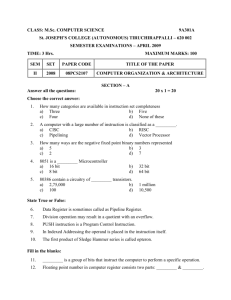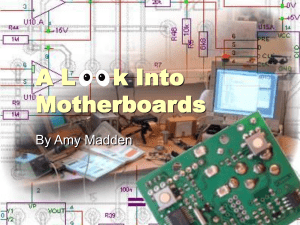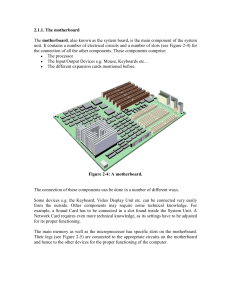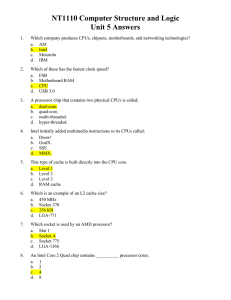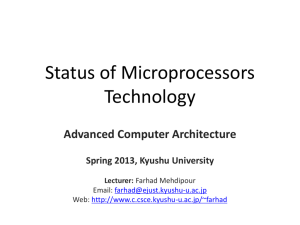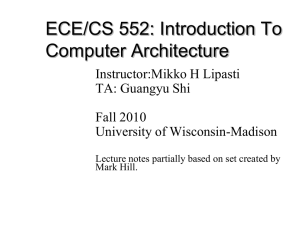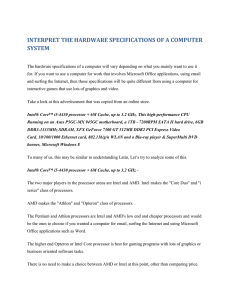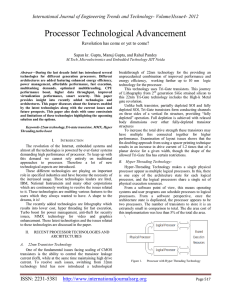ECE Users Pages - Georgia Institute of Technology
advertisement
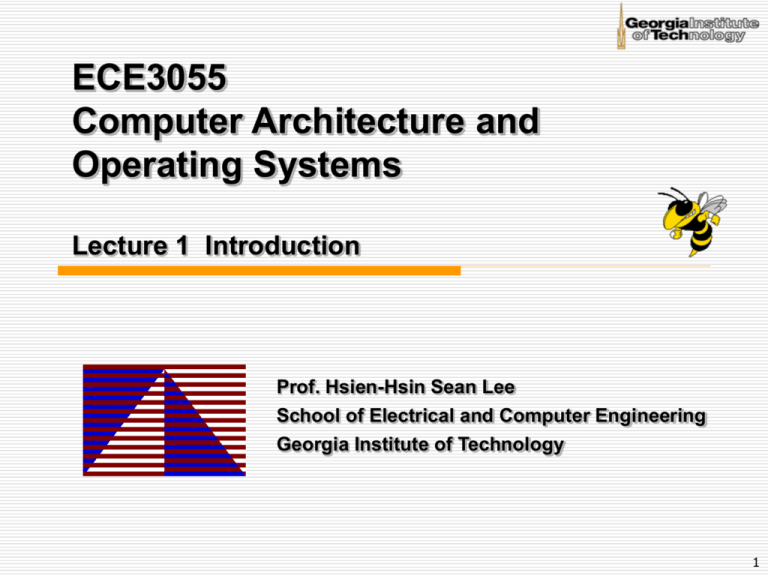
ECE3055
Computer Architecture and
Operating Systems
Lecture 1 Introduction
Prof. Hsien-Hsin Sean Lee
School of Electrical and Computer Engineering
Georgia Institute of Technology
1
Objectives To Learn
Core concepts of microprocessor architecture
ISA (review of 2030)
Pipelining
Hazards
Cache/Memory hierarchy
Memory management
Core concepts of operating systems
Processes/threads
Protection
Resource Management
Scheduling
File System
2
Course Information
Web page: http://www.ece.gatech.edu/~leehs/ECE3055
Will be constantly updated, so check it out regularly
Prerequisite: ECE2031 Digital Design Lab
Textbooks
Patterson and Hennessey, Computer Organization &
Design: The Hardware/Software Interface (3rd
edition), Morgan Kaufmann, 2004. ISBN 1-55860604-1.
Silberschatz, Galvin, and Gagne, Operating System
Concepts with Java (6th edition), John Wiley, 2004.
ISBN 0471489050.
3
Grading Policy
5 Programming Assignments: 35% (5, 10, 10, 5, 5%)
Individual work, no collaboration
Due in the first 5 min before class starts
No late turn-in will ever be accepted
Exams
3 in-class exams: 45% (15% each, dates TBD)
Final: 20% (date on Oscar)
Final Grade is relative to your peer in class
4
Part I: Patterson & Hennessy book
5
Introduction
Rapidly changing field:
vacuum tube -> transistor -> IC -> VLSI (see section 1.4)
doubling every 1.5 years:
memory capacity
processor speed (Due to advances in technology and organization)
Things you’ll be learning:
how computers work, a basic foundation
how to analyze their performance (or how not to!)
issues affecting modern processors (caches, pipelines)
Why learn this stuff?
you want to call yourself a “computer scientist”
you want to build software people use (need performance)
you need to make a purchasing decision or offer “expert” advice
6
Moore’s Law
P4 Extreme Ed.
178 millions w/ 2MB L3
IBM latest POWER5 has
276 million transistors
Intel Dual-Core Xeon (P4-based
Tulsa) w/ 16MB unified L3:
1.328 billion, 2006
2,250
Core 2 Duo (Conroe)
291 millions, July
2006
42 millions
Exponential growth
Transistor count will be doubled every 18 months
Gordon Moore, Intel co-founder
7
Integrated Circuits Capacity
8
Feature Size
We are currently at 0.09µm and moving towards 0.065µm
9
Average Transistor Cost Per Year
10
What is a computer?
Components:
Processor(s)
Co-processors (graphics, security)
Memory (disk drives, DRAM, SRAM, CD/DVD)
input (mouse, keyboard, mic)
output (display, printer)
network
Our primary focus: the processor (datapath and control)
implemented using millions of transistors
Impossible to understand by looking at each transistor
We need...
11
Abstraction
High Level
Language
main() {
int i,b,c,a[10];
for (i=0; i<10; i++)…
a[2] = b + c*i;
}
Compiler
ISA
…
lw r2, mem[r7]
add r3, r4, r2
st
r3, mem[r8]
Delving into the depths
reveals more information
An abstraction omits unneeded
detail,
helps us cope with complexity
What are some of the details
that appear in these familiar
abstractions?
Assembler
12
A Typical PC System Architecture
13
A Typical PC Motherboard (D975XBX)
14
A Typical PC Motherboard (D975XBX)
15
Instruction Set Architecture
A very important abstraction
interface between hardware and low-level software
standardizes instructions, machine language bit patterns, etc.
advantage: different implementations of the same architecture
disadvantage: sometimes prevents using new innovations
True or False: Binary compatibility is extraordinarily important?
Modern instruction set architectures:
80x86 (aka iA32), PowerPC (e.g. G4, G5)
Xscale, ARM, MIPS
Intel/HP EPIC (iA64), AMD64, Intel’s EM64T, SPARC, HP PA-RISC,
DEC/Compaq/HP Alpha
16
Where we are headed
Performance issues
A specific instruction set architecture
Arithmetic and how to build an ALU
Constructing a processor to execute our instructions
Pipelining to improve performance
Memory: caches and virtual memory
I/O
I will try to cover as much as possible, but do not
forget we have another half of the semester for OS
17
